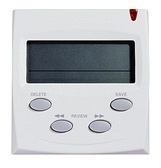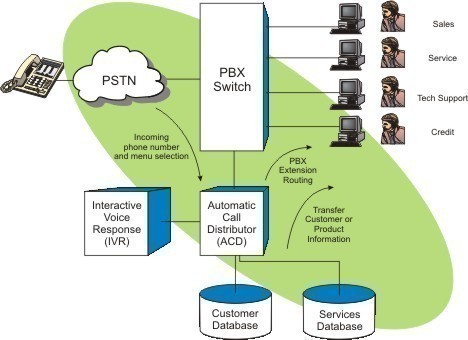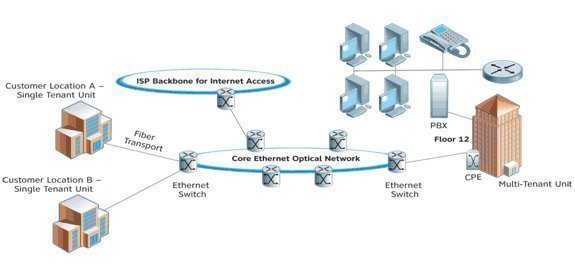Calling Number Delivery (CND), better known as Caller ID, is a telephone service intended for residential and small business customers. It allows the called Customer Premises Equipment (CPE) to receive a calling party's directory number and the date and time of the call during the first 4 second silent interval in the ringing cycle.
Caller-ID Parameters
The data signaling interface has the following characteristics:
| Link Type: | 2-wire, simplex |
| Transmission Scheme: | Analog, phase-coherent FSK |
| Logical 1 (mark) | 1200 +/- 12 Hz |
| Logical 0 (space) | 2200 +/- 22 Hz |
| Transmission Rate: | 1200 bps |
| Transmission Level: | 13.5 +/- dBm into 900 ohm load |
Caller-ID Protocol
The protocol uses 8-bit data words (bytes), each bounded by a start bit and a stop bit. The CND message uses the Single Data Message format shown below.
| Channel Seizure Signal | Carrier Signal | Message Type Word | Message Length Word | Data Word(s) | Checksum Word |
Caller-ID Channel Seizure Signal
The channel seizure is 30 continuous bytes of 55h (01010101) providing a detectable alternating function to the CPE (i.e. the modem data pump).

Caller-ID Carrier Signal
The carrier signal consists of 130 +/- 25 mS of mark (1200 Hz) to condition the receiver for data.
Caller-ID Message Type Word
The message type word indicates the service and capability associated with the data message. The message type word for CND is 04h (00000100).
Caller-ID Message Length Word
The message length word specifies the total number of data words to follow.
Caller-ID Data Words
The data words are encoded in ASCII and represent the following information:
- The first two words represent the month
- The next two words represent the day of the month
- The next two words represent the hour in local military time
- The next two words represent the minute after the hour
- The calling party's directory number is represented by the remaining words in the data word field
If the calling party's directory number is not available to the terminating central office, the data word field contains an ASCII "O". If the calling party invokes the privacy capability, the data word field contains an ASCII "P".
Caller-ID Checksum Word
The Checksum Word contains the twos complement of the modulo 256 sum of the other words in the data message (i.e., message type, message length, and data words). The receiving equipment may calculate the modulo 256 sum of the received words and add this sum to the received checksum word. A result of zero generally indicates that the message was correctly received. Message retransmission is not supported.
Example Caller-ID Data Message
An example of a received CND message, beginning with the message type word, follows:
04 12 30 39 33 30 31 32 32 34 36 30 39 35 35 35 31 32 31 32 51
| 04h | Calling number delivery information code (message type word) |
| 12h | 18 decimal; Number of data words (date, time, and directory number words) |
| 30, 39 | 09; September |
| 33, 30 | 30; 30th day |
| 31, 32 | 12; 12:00 PM |
| 32, 34 | 24; 24 minutes (i.e., 12:24 PM) |
| 36, 30, 39, 35, 35, 35, 31, 32, 31, 32 | (609) 555-1212; calling party's directory number |
| 51h | Chcksum Word |
Caller-ID Data Access Arrangement (DAA) Requirements
To receive CND information, the modem monitors the phone line between the first and second ring bursts without causing the DAA to go off hook in the conventional sense, which would inhibit the transmission of CND by the local central office. A simple modification to an existing DAA circuit easily accomplishes the task.
Caller-ID Modem Requirements
Although the data signaling interface parameters match those of a Bell 202 modem, the receiving CPE need not be a Bell 202 modem. A V.23 1200 bps modem receiver may be used to demodulate the Bell 202 signal. The ring indicate bit (RI) may be used on a modem to indicate when to monitor the phone line for CND information. After the RI bit sets, indicating the first ring burst, the host waits for the RI bit to reset. The host then configures the modem to monitor the phone line for CND information.
Caller-ID Signaling
According to Telcordia specifications, CND signaling starts as early as 300 mS after the first ring burst and ends at least 475 mS before the second ring burst
Caller-ID Applications
Once CND information is received the user may process the information in a number of ways.
- The date, time, and calling party's directory number can be displayed.
- Using a look-up table, the calling party's directory number can be correlated with his or her name and the name displayed.
-
CND information can also be used in additional ways such as for:
- Bulletin board applications
- Black-listing applications
- Keeping logs of system user calls, or
- Implementing a telemarketing data base
Additional Information Regarding Caller-ID
For more information on Calling Number Delivery (CND), refer to Telcordia publications TR-TSY-000030 and TR-TSY-000031.
To obtain Telcordia documents contact:
Telcordia Customer Service 60 New England Avenue, Room 1B252 Piscataway, NJ 08834-4196 (908) 699-5800




Follow Us!